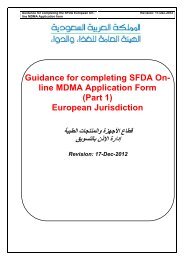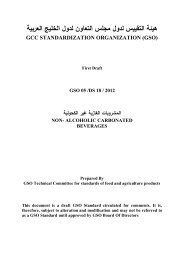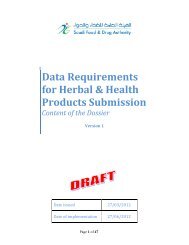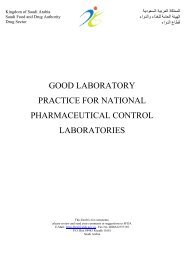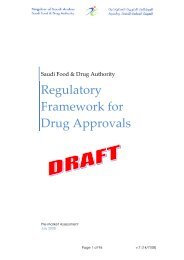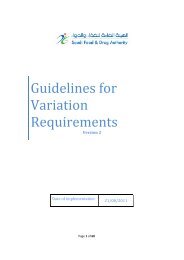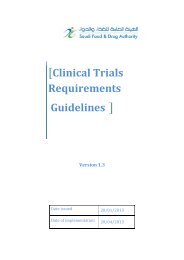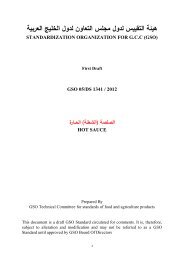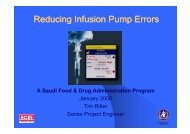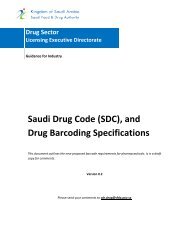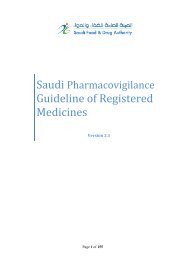The GCC Guidance for Presenting the SPC, PIL and Labeling ...
The GCC Guidance for Presenting the SPC, PIL and Labeling ...
The GCC Guidance for Presenting the SPC, PIL and Labeling ...
- No tags were found...
You also want an ePaper? Increase the reach of your titles
YUMPU automatically turns print PDFs into web optimized ePapers that Google loves.
Executive Board of <strong>the</strong> Health Ministers’ Council <strong>for</strong> <strong>GCC</strong> States<strong>The</strong> <strong>GCC</strong> <strong>Guidance</strong> <strong>for</strong><strong>Presenting</strong> <strong>the</strong> <strong>SPC</strong>, <strong>PIL</strong><strong>and</strong> <strong>Labeling</strong>In<strong>for</strong>mationVersion 1.1Date issued 17/05/2011Date of implementation 17/08/2011Page 1 of 52
Document ControlVersion Date Author(s) Comments1.0 30/01/2010Product Evaluation <strong>and</strong> St<strong>and</strong>ards Published <strong>for</strong> commentsSetting Department1.1 17/05/2011Product Evaluation <strong>and</strong> St<strong>and</strong>ards Final versionSetting DepartmentPage 2 of 52
ContentsI. Introduction 4II. <strong>Labeling</strong> 51. Particulars to appear on <strong>the</strong> 52. Minimum particulars to appear on blisters or strips 83. Minimum particulars to appear on small immediate packaging units 9III. Patient In<strong>for</strong>mation Leaflet (<strong>PIL</strong>) 111. What {product name} is <strong>and</strong> what it is used <strong>for</strong> 132. Be<strong>for</strong>e you {product name} 133. How to {product name} 15. ٤ Possible side effects 16. ٥ How to store {product name} 166. Fur<strong>the</strong>r in<strong>for</strong>mation 17IV. Summary of Product Characteristics (<strong>SPC</strong>) 191. Name of <strong>the</strong> medicinal product 192. Qualitative <strong>and</strong> quantitative composition 193. Pharmaceutical <strong>for</strong>m 194. Clinical particulars 205. Pharmacological properties 236. Pharmaceutical particulars 267. Marketing authorisation holder 288. Marketing authorisation number(s) 289. Date of first Authorisation/ renewal of <strong>the</strong> authorisation 2810. Date of revision of <strong>the</strong> text 2811. 2912. 29Appendix 5: Additional in<strong>for</strong>mation that are required to be translated into Arabic language 37Appendix 6: Readability of <strong>the</strong> label <strong>and</strong> patient in<strong>for</strong>mation leaflet (<strong>PIL</strong>) 42References 52Page 3 of 52
I. Introduction<strong>The</strong>se guidelines are adapted from <strong>the</strong> EMEA Notice to applicants <strong>and</strong> regulatory guidelinesmedicinal products <strong>for</strong> human use, EudraLex - Volume 2.This document is indented to guide applicants on how to present <strong>the</strong> required in<strong>for</strong>mation by <strong>the</strong>Gulf Cooperation Council (<strong>GCC</strong>) States <strong>for</strong>:• Summary of Product Characteristics (<strong>SPC</strong>);• Patient In<strong>for</strong>mation Leaflet (<strong>PIL</strong>); <strong>and</strong>• <strong>Labeling</strong>.<strong>The</strong> <strong>SPC</strong> is <strong>the</strong> basis of in<strong>for</strong>mation <strong>for</strong> health professionals on how to use <strong>the</strong> medicinal productsafely <strong>and</strong> effectively. <strong>The</strong> Patient In<strong>for</strong>mation Leaflet (<strong>PIL</strong>) shall be drawn up in accordancewith <strong>the</strong> <strong>SPC</strong>.This guideline provides advice on <strong>the</strong> principles of presenting in<strong>for</strong>mation. Applicants shouldmaintain <strong>the</strong> integrity of each section of <strong>the</strong> document by only including in<strong>for</strong>mation in eachsection, which is relevant to <strong>the</strong> section heading. However, some issues may need to beaddressed in more than one section <strong>and</strong> in such situations <strong>the</strong> individual statements may crossreferto o<strong>the</strong>r sections when <strong>the</strong>se contain relevant additional in<strong>for</strong>mation.When submitting a new application <strong>for</strong> registration, renewal or variation, <strong>the</strong> in<strong>for</strong>mationpresented by <strong>the</strong> applicant regarding <strong>the</strong> <strong>SPC</strong>, <strong>PIL</strong> <strong>and</strong> labeling must follow this guidance.Additionally, it should be noted that pharmaceutical products with different strengths must havedifferent packaging color codes that differentiate between different strengths. Fur<strong>the</strong>rmore, <strong>the</strong>applicant must provide Arabic translation of <strong>the</strong> in<strong>for</strong>mation on <strong>the</strong> outer package including:name of <strong>the</strong> medicinal product along with storage conditions <strong>for</strong> all medicines except those usedsolely in hospitals.Following <strong>the</strong> <strong>GCC</strong>'s approval of <strong>the</strong> <strong>SPC</strong>, <strong>PIL</strong> <strong>and</strong> labeling contents, such contents cannot bechanged except with <strong>the</strong> approval of <strong>the</strong> <strong>GCC</strong> (refer to guidelines <strong>for</strong> variation requirements).Page 4 of 52
II. <strong>Labeling</strong><strong>The</strong> data should be presented according to <strong>the</strong> template below, irrespectively of <strong>the</strong>ir sequenceon <strong>the</strong> actual labeling <strong>and</strong> <strong>the</strong>ir position <strong>and</strong> possible repetition on <strong>the</strong> individual sides/flaps of<strong>the</strong> packaging (e.g. top flap, front, back etc.).A separate text <strong>for</strong> outer <strong>and</strong> inner packaging labeling should be completed per strength <strong>and</strong> perpharmaceutical <strong>for</strong>m.Bracketing convention:{text}:In<strong>for</strong>mation to be filled in.:Text to be selected or deleted as appropriate.1. Particulars to appear on <strong>the</strong> a. Name of <strong>the</strong> medicinal product{(Invented) name strength pharmaceutical <strong>for</strong>m}{Active substance(s)}• Note: <strong>The</strong> invented (trade) name in Arabic language should be added.b. Statement of active substance(s)Expressed qualitatively <strong>and</strong> quantitatively per dosage unit or according to <strong>the</strong> <strong>for</strong>m ofadministration <strong>for</strong> a given volume or weight. Where <strong>the</strong> active substance is present asa salt, this should be clearly indicated.c. List of excipientsExpress qualitatively those excipients known to have a recognised action or effect.However, if <strong>the</strong> medicinal product is a parenteral, a topical or an eye preparation or ifused <strong>for</strong> inhalation, all excipients must be stated.Page 5 of 52
d. Pharmaceutical <strong>for</strong>m <strong>and</strong> contentsContents by weight, by volume or by number of doses or number of units ofadministration of <strong>the</strong> medicinal product (e.g. 28 tablets, 100 mL, ...)e. Method <strong>and</strong> route(s) of administrationMethod of administration: directions <strong>for</strong> proper use of <strong>the</strong> medicinal product, e.g. “Donot swallow”, “Do not chew”, “Shake well be<strong>for</strong>e use”. In all cases, <strong>and</strong> especially iffull details cannot be included on <strong>the</strong> outer packaging itself, a reference to <strong>the</strong> patientin<strong>for</strong>mation leaflet must be made:Read <strong>the</strong> patient in<strong>for</strong>mation leaflet be<strong>for</strong>e use.f. Special warning that <strong>the</strong> medicinal product must be stored out of <strong>the</strong> reach <strong>and</strong> sight ofchildrenKeep out of <strong>the</strong> reach <strong>and</strong> sight of children.g. O<strong>the</strong>r special warning(s), if necessaryh. Manufacturing <strong>and</strong> Expiry datesDates should be expressed with <strong>the</strong> month given as 2 digits or 3 characters <strong>and</strong> <strong>the</strong> yearas 4 digits. e.g.: 02/2010, Feb 2010.Where applicable, <strong>the</strong> shelf life after reconstitution, dilution or after first opening <strong>the</strong>container should be included.i. Special storage conditions[For recommended labeling statements see Appendix 1]• Note: Storage conditions in Arabic language should be added.Page 6 of 52
j. Special precautions <strong>for</strong> disposal of unused medicinal products or waste materials derivedfrom such medicinal products, if appropriate[E.g. radiopharmaceuticals, cytostatics.][A reference to any appropriate collection system in place should be included on <strong>the</strong>outer packaging.]k. Name <strong>and</strong> address of <strong>the</strong> marketing authorisation holder{Name <strong>and</strong> Address}l. Marketing authorisation number(s)m. Batch number {number}n. General classification <strong>for</strong> supplyo. PricePage 7 of 52
2. Minimum particulars to appear on blisters or stripsa. Name of <strong>the</strong> medicinal product{(Invented) name strength pharmaceutical <strong>for</strong>m}{Active substance(s)}b. Name of <strong>the</strong> marketing authorisation holder{Name}c. Manufacturing <strong>and</strong> Expiry datesDates should be expressed with <strong>the</strong> month given as 2 digits or 3 characters <strong>and</strong> <strong>the</strong> year as 4digits. e.g.: 02/2010, Feb 2010.d. Batch number {number}e. O<strong>the</strong>r[Space permitting, any o<strong>the</strong>r in<strong>for</strong>mation necessary <strong>for</strong> <strong>the</strong> correct use <strong>and</strong> administrationof <strong>the</strong> product can be included here, e.g. calendar days.]Page 8 of 52
3. Minimum particulars to appear on small immediate packaging unitsSmall immediate packaging units are defined as containers sized up to <strong>and</strong> including 10 ml.On a case-by-case basis <strong>the</strong> minimum particulars could also be considered <strong>for</strong> o<strong>the</strong>rcontainers where it is not be feasible to include all <strong>the</strong> in<strong>for</strong>mation. Such exceptional caseshave to be justified, discussed <strong>and</strong> agreed upon with <strong>the</strong> <strong>GCC</strong>.a. Name of <strong>the</strong> medicinal product <strong>and</strong> route(s) of administration{(Invented) name strength pharmaceutical <strong>for</strong>m}{Active substance(s)}{Route of administration}b. Method of administrationMethod of administration: directions <strong>for</strong> proper use of <strong>the</strong> medicinal product, e.g. “Do notswallow”, “Do not chew”, “Shake well be<strong>for</strong>e use”. If full details cannot be included on<strong>the</strong> immediate packaging itself, a reference to <strong>the</strong> patient in<strong>for</strong>mation leaflet should bemade, e.g. “Read <strong>the</strong> patient in<strong>for</strong>mation leaflet be<strong>for</strong>e use”.c. Manufacturing <strong>and</strong> Expiry datesDates should be expressed with <strong>the</strong> month given as 2 digits or 3 characters <strong>and</strong> <strong>the</strong> yearas 4 digits. e.g.: 02/2010, Feb 2010.Where applicable, <strong>the</strong> shelf life after reconstitution, dilution or after first opening <strong>the</strong>container should be included.d. Batch number {number}e. Contents by weight, by volume or by unitPage 9 of 52
FAMILIARISATIONSITTING COMFORTABLYFront seatsHead restraint heightiO<strong>the</strong>r functions available...Table position <strong>for</strong> <strong>the</strong> frontpassenger seat (SW).Storing driving positions (driver'selectric seat).Heated seats.Front armrestSteering wheel adjustmentLumbar1. Unlocking <strong>the</strong> control.2. Adjustment <strong>for</strong> height <strong>and</strong> reach.3. Locking <strong>the</strong> control.!As a safety precaution, <strong>the</strong>seoperations must only be carriedout when stationary.For your com<strong>for</strong>t, <strong>the</strong> height <strong>and</strong>longitudinal position of <strong>the</strong> front armrestcan be adjusted.It also has a storage compartment.12 65 77 106APp-308BB_01_2010_anglais_cag_pd12 12 04/11/2010 16:27:17
III. Patient In<strong>for</strong>mation Leaflet (<strong>PIL</strong>)A separate patient in<strong>for</strong>mation leaflet should be provided per strength <strong>and</strong> per pharmaceutical<strong>for</strong>m. However, applicants may present patient in<strong>for</strong>mation leaflets <strong>for</strong> different strengths in onedocument during <strong>the</strong> evaluation process, clearly indicating <strong>the</strong> strength or presentation to whichalternative text elements refer. Where applicants consider to also market a combined packageleaflet, a detailed justification <strong>for</strong> such a combined patient in<strong>for</strong>mation leaflet should be providedin <strong>the</strong> application at submission.<strong>The</strong> following items must appear in <strong>the</strong> patient in<strong>for</strong>mation leaflet as required by this guidance.In exceptional cases, alternative headings may be acceptable, especially <strong>for</strong> those headingscontaining or where a different wording would be more appropriate <strong>for</strong> <strong>the</strong> productconcerned e.g. to better reflect <strong>the</strong> user of <strong>the</strong> product. This should not in any case impact on <strong>the</strong>content required <strong>for</strong> <strong>the</strong> section concerned. Applicants should justify <strong>the</strong> use of alternativeheadings (e.g. by reference to user testing results). For certain medicinal products not all itemsmay be relevant, in this case <strong>the</strong> corresponding heading should not be included.It is important that <strong>the</strong> <strong>PIL</strong> can easily be tracked <strong>for</strong> updates <strong>and</strong> review. Each <strong>PIL</strong> should begiven a reference number along with <strong>the</strong> date <strong>the</strong> leaflet was issued <strong>and</strong> a suitable review date.Each <strong>PIL</strong> should be reviewed every 5 years or when necessary.Bracketing convention:{text}: In<strong>for</strong>mation to be filled in.: Text to be selected or deleted as appropriate.Page 11 of 52
Patient In<strong>for</strong>mation Leaflet (<strong>PIL</strong>){(Invented) name strength pharmaceutical <strong>for</strong>m}{Active substance(s)}<strong>The</strong> (invented) name of <strong>the</strong> medicinal product (referred to as X throughout this document)followed by <strong>the</strong> strength <strong>and</strong> pharmaceutical <strong>for</strong>m (i.e. as it appears in <strong>the</strong> <strong>SPC</strong>) should bestated here in bold. This should be followed by <strong>the</strong> active substance(s) (as stated on <strong>the</strong>label section 1), which may be written on <strong>the</strong> line below.In this leaflet:1. What {product name}is <strong>and</strong> what it is used <strong>for</strong>2. Be<strong>for</strong>e you {product name}3. How to {product name}4. Possible side effects5. How to store {product name}6. Fur<strong>the</strong>r in<strong>for</strong>mationPage 12 of 52
1. What {product name} is <strong>and</strong> what it is used <strong>for</strong>− Pharmaco<strong>the</strong>rapeutic group:<strong>The</strong> pharmaco<strong>the</strong>rapeutic group or type of activity should be stated here using patientunderst<strong>and</strong>able language.− <strong>The</strong>rapeutic indications:<strong>The</strong> <strong>the</strong>rapeutic indications should be stated here, using patient underst<strong>and</strong>ablelanguage. If appropriate, specify that:2. Be<strong>for</strong>e you {product name}a. Do not {product name}− − b. Take special care with {product name}− − − c. o<strong>the</strong>r medicines, herbal or dietary supplements− Describe <strong>the</strong> effects of o<strong>the</strong>r products on {product name} <strong>and</strong> vice versa.Page 13 of 52
d. {product name} with food <strong>and</strong> drink− Interactions not related to medicinal products should be mentioned here. Where relevant,guidance should always be included to clarify if <strong>the</strong> medicine must be taken with food,during/be<strong>for</strong>e meals, or clearly state if food/meals have no influence, etc.e. Pregnancy <strong>and</strong> breast-feeding− Where <strong>the</strong> in<strong>for</strong>mation is significantly different, pregnancy <strong>and</strong> breast-feedingin<strong>for</strong>mation can be presented under separate headings.− Include conclusion summary of <strong>the</strong> in<strong>for</strong>mation given in <strong>the</strong> <strong>SPC</strong>, in addition to <strong>the</strong>following optional statement:f. Driving <strong>and</strong> using machines− − g. Important in<strong>for</strong>mation about some of <strong>the</strong> ingredients of {product name}− If appropriate, details of those excipients knowledge of which is important <strong>for</strong> <strong>the</strong> safe<strong>and</strong> effective use of <strong>the</strong> medicinal product, including relevant warnings <strong>for</strong> residuesfrom <strong>the</strong> manufacturing process.Page 14 of 52
3. How to {product name} − You may include <strong>the</strong> following sub-headings within <strong>the</strong> headings given below if needed toincrease readability:• Instructions <strong>for</strong> proper use• Dosage• Method <strong>and</strong>/or route(s) of administration• Frequency of administration• Duration of treatmenta. If you more {product name} than you should• Describe how to recognise if someone has taken an overdose <strong>and</strong> what to do.b. If you <strong>for</strong>get to {product name}• Make clear to patients what <strong>the</strong>y should do after irregular use of a product; e.g.c. If you stop {product name}• Indicate any effects of interrupting or ending <strong>the</strong> treatment early, if applicable.• Indicate withdrawal effects when <strong>the</strong> treatment ends, when necessary.• As appropriate, close this section with:Page 15 of 52
4. Possible side effects− Describe <strong>the</strong> side effects <strong>and</strong> whenever possible, an estimate of frequency should be provided,expressed in st<strong>and</strong>ard category of frequency (see Appendix 2).− Begin this section with: "Like all medicines, {product name} can cause side effects, althoughnot everybody gets <strong>the</strong>m".− Describe, if necessary, <strong>the</strong> actions to be taken. If <strong>the</strong> patient needs to seek help urgently, <strong>the</strong>use of <strong>the</strong> term is recommended; <strong>for</strong> less urgent conditions, can be used.− Close this section with: "If any of <strong>the</strong> side effects gets serious, or if you notice any side effectsnot listed in this leaflet, please tell your ".5. How to store {product name}− Keep out of <strong>the</strong> reach <strong>and</strong> sight of children.− , − Do not use {product name} after <strong>the</strong> expiry date which is stated on <strong>the</strong> − − Page 16 of 52
d. This leaflet was last approved in {MM/YYYY}; version number { }e. To report any side effect(s):• Saudi Arabia:− National Pharmacovigilance Center (NPC)o Fax: +966-1-210-7398o E-mail: npc.drug@sfda.gov.sao Website: www.sfda.gov.sa/npc• O<strong>the</strong>r <strong>GCC</strong> States:− Please contact <strong>the</strong> relevant competent authority.f. Council of Arab Health Ministers<strong>The</strong> following statements issued by <strong>the</strong> Council of Arab Health Ministers should beprinted in <strong>the</strong> <strong>PIL</strong>.This is a Medicament− Medicament is a product which affects your health <strong>and</strong> its consumption contrary toinstructions is dangerous <strong>for</strong> you.− Follow strictly <strong>the</strong> doctor’s prescription, <strong>the</strong> method of use <strong>and</strong> <strong>the</strong> instructions of <strong>the</strong>pharmacist who sold <strong>the</strong> medicament.− <strong>The</strong> doctor <strong>and</strong> <strong>the</strong> pharmacist are <strong>the</strong> experts in medicines, <strong>the</strong>ir benefits <strong>and</strong> risks.− Do not by yourself interrupt <strong>the</strong> period of treatment prescribed <strong>for</strong> you.− Do not repeat <strong>the</strong> same prescription without consulting your doctor.− Keep all medicaments out of reach of children.Council of Arab Health MinistersUnion of Arab PharmacistsPage 18 of 52
IV. Summary of Product Characteristics (<strong>SPC</strong>)During <strong>the</strong> evaluation process, applicants may present <strong>SPC</strong>s <strong>for</strong> different strengths in onedocument, clearly indicating with grey-shaded titles <strong>the</strong> strength or presentation to whichalternative text elements refer. However, a separate <strong>SPC</strong> per strength <strong>and</strong> per pharmaceutical<strong>for</strong>m, containing all pack-sizes related to <strong>the</strong> strength <strong>and</strong> pharmaceutical <strong>for</strong>m concerned willhave to be provided by <strong>the</strong> applicant.Bracketing convention:{text}: In<strong>for</strong>mation to be filled in.: Text to be selected or deleted as appropriate.1. Name of <strong>the</strong> medicinal product<strong>The</strong> name should be followed by both <strong>the</strong> strength <strong>and</strong> <strong>the</strong> pharmaceutical <strong>for</strong>m.{(Invented) name strength pharmaceutical <strong>for</strong>m}2. Qualitative <strong>and</strong> quantitative composition− Full details of <strong>the</strong> qualitative <strong>and</strong> quantitative composition in terms of <strong>the</strong> activesubstance(s) <strong>and</strong> excipients.− A st<strong>and</strong>ard statement should be included at <strong>the</strong> end of <strong>the</strong> section, i.e. ‘For a full list ofexcipients, see section 6.1.3. Pharmaceutical <strong>for</strong>m− Full description of <strong>the</strong> pharmaceutical <strong>for</strong>m should be provided.− It is recommended that a visual description of <strong>the</strong> appearance of <strong>the</strong> product (color,markings, etc.) is given, including in<strong>for</strong>mation on pH <strong>and</strong> osmolarity as required e.g.:‘Tablet White, circular flat bevelled-edge tablets marked ‘100’ on one side’.Page 19 of 52
− In case of tablets designed with a score line, in<strong>for</strong>mation should be given whe<strong>the</strong>r or notreproducible dividing of <strong>the</strong> tablets has been shown. e.g.:.4. Clinical particulars4.1 <strong>The</strong>rapeutic indications− <strong>The</strong> indication(s) should be stated clearly <strong>and</strong> concisely <strong>and</strong> should define <strong>the</strong> targetdisease or condition distinguishing between treatment (symptomatic, curative ormodifying <strong>the</strong> evolution or progression of <strong>the</strong> disease), prevention (primary orsecondary) <strong>and</strong> diagnostic indication. When appropriate it should define <strong>the</strong> targetpopulation especially when restrictions to <strong>the</strong> patient populations apply.− When <strong>the</strong> product is indicated in a specific age group such as children/adolescents, <strong>the</strong>indication should state <strong>the</strong> age limit e.g. ‘X is indicated in from <strong>the</strong> age of X ‘.4.2 Posology <strong>and</strong> method of administration− In case of restricted medical prescription start this section by specifying <strong>the</strong> conditions.− <strong>The</strong> route of administration <strong>and</strong> concise relevant instruction <strong>for</strong> correct administration<strong>and</strong> use should be given here.− Instructions <strong>for</strong> preparation are to be placed under section 6.6 or 12, <strong>and</strong> crossreferencedhere.− Dose recommendations (e.g. mg, mg/kg, mg/m 2 ) should be specified per dose interval <strong>for</strong>each category where appropriate (specify age/weight/body surface area of subsets of <strong>the</strong>population as appropriate). Frequency of dosing should be expressed using time units(e.g. once or twice daily or every 6 hour) <strong>and</strong>, to avoid confusion, abbreviations e.g. ODor BID should not be used.Page 20 of 52
− Dosage adjustments or o<strong>the</strong>r posology related in<strong>for</strong>mation on special populations shouldbe presented here, in well-defined sub-sections ordered by importance, e.g. regarding:elderly population; paediatric population; renal impairment; hepatic impairment,patients with a particular genotype; o<strong>the</strong>r relevant special population (e.g. patients witho<strong>the</strong>r concomitant disease or overweight patients).4.3 Contraindications− Situations where <strong>the</strong> medicinal product must not be given <strong>for</strong> safety reasons, i.e.contraindications, are <strong>the</strong> subject of this section.4.4 Special warnings <strong>and</strong> precautions <strong>for</strong> use− <strong>The</strong> order of warnings <strong>and</strong> precautions should be determined by <strong>the</strong> importance of <strong>the</strong>safety in<strong>for</strong>mation provided.4.5 Interaction with o<strong>the</strong>r medicinal products <strong>and</strong> o<strong>the</strong>r <strong>for</strong>ms of interaction− This section should provide in<strong>for</strong>mation on <strong>the</strong> potential <strong>for</strong> clinically relevantinteractions based on <strong>the</strong> pharmacodynamic properties <strong>and</strong> in vivo pharmacokineticstudies of <strong>the</strong> medicinal product, with a particular emphasis on <strong>the</strong> interactions, whichresult in a recommendation regarding <strong>the</strong> use of this medicinal product.− If no interaction studies have been per<strong>for</strong>med, this should be clearly stated.4.6 Fertility, Pregnancy <strong>and</strong> lactation− Ef<strong>for</strong>ts should be made by <strong>the</strong> Marketing Authorization Applicant or Holder to provide<strong>the</strong> reasons <strong>for</strong> <strong>the</strong> recommendations <strong>for</strong> use in pregnant or lactating women <strong>and</strong> inwomen of childbearing potential. This in<strong>for</strong>mation is important <strong>for</strong> <strong>the</strong> healthcareprofessionals in<strong>for</strong>ming <strong>the</strong> patient.Page 21 of 52
− In <strong>the</strong> overall assessment, all available knowledge should be taken into account,including clinical studies <strong>and</strong> post-marketing surveillance, pharmacological activity,results from non-clinical studies, <strong>and</strong> knowledge about compounds within <strong>the</strong> same class.− Ef<strong>for</strong>ts should be made to update <strong>the</strong> recommendations <strong>for</strong> use during pregnancy <strong>and</strong>lactation on <strong>the</strong> basis of increasing human experience in exposed pregnancies whicheventually supersede <strong>the</strong> animal data.− <strong>The</strong> following should be mentioned:o Women of childbearing potential / Contraception in males <strong>and</strong> females.o Pregnancyo Breastfeedingo Fertility− [For Pregnancy <strong>and</strong> lactation statements see Appendices 3 & 4 ]4.7 Effects on ability to drive <strong>and</strong> use machines− On <strong>the</strong> basis of <strong>the</strong> pharmacodynamic profile, reported Adverse Reactions <strong>and</strong>/or specificstudies on a relevant target population addressing <strong>the</strong> per<strong>for</strong>mance related to driving orusing machines, specify whe<strong>the</strong>r <strong>the</strong> medicinal product has:a. no or negligible influence;b. minor or moderate influence, orc. major influence on <strong>the</strong>se abilities.Effects of <strong>the</strong> disease itself on <strong>the</strong>se abilities should not be discussed.Page 22 of 52
4.8 Undesirable effects− This section should include all adverse reactions from clinical trials, post-authorizationsafety studies <strong>and</strong> spontaneous reporting.− Within each frequency grouping, undesirable effects are presented in order of decreasingseriousness.4.9 Overdose− Describe acute symptoms <strong>and</strong> signs <strong>and</strong> potential sequelae of different dose levels of <strong>the</strong>medicinal product based on all available in<strong>for</strong>mation including accidental intake,mistakes <strong>and</strong> suicide attempts by patients.− Taking into account all relevant evidence, describe management of overdose in man, e.g.in relation to monitoring or use of specific agonists/antagonists, antidotes or methods toincrease elimination of <strong>the</strong> medicinal product such as dialysis.5. Pharmacological properties5.1 Pharmacodynamic propertiesDescribe <strong>the</strong> following:− Pharmaco<strong>the</strong>rapeutic group: {group}, ATC code: {code}. If an ATC code is not yetavailable, this should be mentioned as ‘not yet assigned’.− Mechanism of action (if known).− Pharmacodynamic effects.− Clinical efficacy <strong>and</strong> safety.5.2 Pharmacokinetic properties− Pharmacokinetic properties of <strong>the</strong> active substance(s) relevant <strong>for</strong> <strong>the</strong> advised dose,strength <strong>and</strong> <strong>the</strong> pharmaceutical <strong>for</strong>mulation marketed should be given in this section. IfPage 23 of 52
<strong>the</strong>se are not available, results obtained with o<strong>the</strong>r administration routes, o<strong>the</strong>rpharmaceutical <strong>for</strong>ms or doses can be given as alternative.− Basic primary pharmacokinetic parameters, <strong>for</strong> instance bioavailability, clearance <strong>and</strong>half-life, should be given as mean values with a measure of variability.− Pharmacokinetics items, which could be included in this section when relevant, are givenbelow.a. General introduction, in<strong>for</strong>mation about whe<strong>the</strong>r <strong>the</strong> medicinal product is a prodrugor whe<strong>the</strong>r <strong>the</strong>re are active metabolites, chirality, solubility etc.b. General characteristics of <strong>the</strong> active substance(s) after administration of <strong>the</strong>medicinal product <strong>for</strong>mulation to be marketed.• Absorption: complete or incomplete absorption; absolute <strong>and</strong>/or relativebioavailability; first pass effect; T max ; <strong>the</strong> influence of food; in case oflocally applied medicinal product <strong>the</strong> systemic bioavailability.• Distribution: plasma protein binding; volume of distribution; tissue <strong>and</strong>/orplasma concentrations; pronounced multi-compartment behavior.• Biotrans<strong>for</strong>mation: degree of metabolism; which metabolites; activity ofmetabolites; enzymes involved in metabolism; site of metabolism; resultsfrom in vitro interaction studies that indicate whe<strong>the</strong>r <strong>the</strong> new compoundcan induce/inhibit metabolic enzymes.• Elimination: elimination half-lives, <strong>the</strong> total clearance; inter <strong>and</strong>/or intrasubjectvariability in total clearance; excretion routes of <strong>the</strong> unchangedsubstance <strong>and</strong> <strong>the</strong> metabolites.• Linearity/non-linearity: linearity/non-linearity of <strong>the</strong> pharmacokinetics of<strong>the</strong> new compound with respect to dose <strong>and</strong>/or time; if <strong>the</strong>pharmacokinetics are nonlinear with respect to dose <strong>and</strong>/or time, <strong>the</strong>underlying reason <strong>for</strong> <strong>the</strong> non-linearity should be presented.Page 24 of 52
− Additional relevant in<strong>for</strong>mation should be included here.a. Characteristics in patients• Variations with respect to factors such as age, gender, smoking status,polymorphic metabolism <strong>and</strong> concomitant pathological situations such asrenal failure, hepatic insufficiency, including degree of impairment. If thisinfluence on <strong>the</strong> pharmacokinetics is considered to be clinically relevant,it should be described here in quantitative terms (cross-referral to 4.2when applicable).b. Pharmacokinetic/pharmacodynamic relationship(s)• Relationship between dose/concentration/pharmacokinetic parameter <strong>and</strong>effect (ei<strong>the</strong>r true endpoint, validated surrogate endpoint or a side effect).• Contribution (if any) of metabolite(s) to <strong>the</strong> effect.5.3 Preclinical safety data− <strong>The</strong> findings of <strong>the</strong> non-clinical testing should be described in brief <strong>and</strong> qualitativestatements as outlined in <strong>the</strong> following example statements:− Conclusions on <strong>the</strong> environmental risk assessment on <strong>the</strong> product should be includedwhere relevant, with reference to section 6.6.Page 25 of 52
6. Pharmaceutical particulars6.1 List of excipients− A list should be given of <strong>the</strong> excipients, expressed qualitatively only. All excipients, whichare present in <strong>the</strong> product, should be included, even those present in small amounts, suchas printing inks.− Each to be listed on a separate line according to <strong>the</strong> different parts of <strong>the</strong> product.6.2 Incompatibilities− In<strong>for</strong>mation on physical <strong>and</strong> chemical incompatibilities of <strong>the</strong> medicinal product witho<strong>the</strong>r products with which it is likely to be mixed or co-administered should be stated.− Statements concerning compatibility of <strong>the</strong> product with o<strong>the</strong>r medicinal products ordevices should not be included in this section but in section 6.6. Statements concerningpharmacological incompatibilities with food should be included in section 4.5.− If appropriate, <strong>the</strong> st<strong>and</strong>ard statement, ‘Not applicable’, should be included.− For certain pharmaceutical <strong>for</strong>ms, e.g. parenterals, ei<strong>the</strong>r of <strong>the</strong> following st<strong>and</strong>ardstatements should be included as appropriate:6.3 Shelf life− In<strong>for</strong>mation on <strong>the</strong> finished product shelf life <strong>and</strong> on <strong>the</strong> in-use stability after 1 st opening<strong>and</strong>/or reconstitution/dilution should appear here. Only one overall shelf life <strong>for</strong> <strong>the</strong>finished product is to be given even if different components of <strong>the</strong> product may have adifferent shelf life (e.g. powder & solvent). Page 26 of 52
6.4 Special precautions <strong>for</strong> storage− General storage conditions of <strong>the</strong> finished product should appear here, toge<strong>the</strong>r with across-reference to section 6.3 where appropriate:− [For recommended labeling statements see Appendix 1]6.5 Nature <strong>and</strong> contents of container− <strong>The</strong> material of construction of <strong>the</strong> immediate container should be stated (‘Type I glassvials’, ‘PVC/Aluminium blisters’, ‘HDPE bottles’); <strong>and</strong> any o<strong>the</strong>r component of <strong>the</strong>product should be listed, e.g. needles, swabs, measuring spoons, inhaler devices,desiccant. <strong>The</strong> container of any solvent provided with <strong>the</strong> medicinal product should alsobe described. Excessive detail, e.g., concerning <strong>the</strong> color of <strong>the</strong> stopper, <strong>the</strong> nature of <strong>the</strong>heat-seal lacquer, should usually not be included. Examples on <strong>the</strong> text in this section:‘ ml suspension in a pre-filled syringe (type I glass) with plunger stopper(chlorobutyl rubber) with or without needle in pack sizes of 5 or 10.’‘HDPE bottle with a child-resistant closure <strong>and</strong> a silica gel desiccant. Pack-sizes of 30,60 or 90 filmcoated tablets.’− All pack sizes must be listed. Pack sizes mentioned should include <strong>the</strong> number of units,number of doses (<strong>for</strong> e.g. multi-dose vaccines, inhalers, etc.), total weight or volume of<strong>the</strong> immediate container, as appropriate, <strong>and</strong> <strong>the</strong> number of containers present in anyouter carton. If applicable, add:Page 27 of 52
6.6 Special precautions <strong>for</strong> disposal − Include practical instructions <strong>for</strong> preparation <strong>and</strong> h<strong>and</strong>ling of <strong>the</strong> product, whereapplicable, including disposal of <strong>the</strong> medicinal product, <strong>and</strong> waste materials derivedfrom <strong>the</strong> used medicinal product.− If applicable, e.g. <strong>for</strong> cytotoxics, <strong>the</strong> following st<strong>and</strong>ard statement should be included,‘Any unused product or waste material should be disposed of in accordance with localrequirements.’− If <strong>the</strong>re are no special use or h<strong>and</strong>ling instructions <strong>for</strong> <strong>the</strong> pharmacist or o<strong>the</strong>r healthcareprofessionals, <strong>the</strong> following st<strong>and</strong>ard statement should be included:7. Marketing authorisation holder{Name <strong>and</strong> address}8. Marketing authorisation number(s)9. Date of first Authorisation/ renewal of <strong>the</strong> authorisation 10. Date of revision of <strong>the</strong> text{MM/YYYY}Page 28 of 52
11. − For radiopharmaceuticals, full details of internal radiation dosimetry.12. − − For radiopharmaceuticals, additional detailed instructions <strong>for</strong> extemporaneouspreparation <strong>and</strong> quality control of such preparation <strong>and</strong>, where appropriate, maximumstorage time during which any intermediate preparation such as an eluate or <strong>the</strong> readyto-usepharmaceutical will con<strong>for</strong>m to its specifications.Page 29 of 52
Appendix 1: Recommended labeling statements• <strong>The</strong> statements that should be used if supported by <strong>the</strong> stability studies <strong>for</strong> finishedpharmaceutical products (FPPs) are listed in Table 1.Table 1: Recommended labeling statements <strong>for</strong> finished pharmaceutical products (FPPs)Testing condition under which <strong>the</strong> stability of<strong>the</strong> FPP has been demonstratedRecommended labeling statement30 °C/65% RH (long-term)40 °C/75% RH (accelerated)“Do not store above 30 °C” *5 °C ± 3 °C ”Store in a refrigerator (2 °C to 8 °C)”-20 °C ± 5 °C “Store in freezer”*“Protect from moisture” should be added as applicable.• Additional labeling statements that could be used in cases where <strong>the</strong> result of <strong>the</strong> stabilitytesting demonstrates limiting factors are listed in Table 2.Table 2: Additional labeling statements <strong>for</strong> use where <strong>the</strong> result of <strong>the</strong> stability testingdemonstrates limiting factorsLimiting factorsAdditional labeling statements, where relevantFPPs that cannot tolerate refrigerationFPPs that cannot tolerate freezingLight-sensitive FPPsFPPs that cannot tolerate excessive heat, e.g.suppositoriesHygroscopic FPPs"Do not refrigerate or freeze""Do not freeze""Protect from light"“Store <strong>and</strong> transport not above 30 °C”“Store in dry condition”Page 30 of 52
Appendix 2: Frequency of adverse drug reactions• <strong>The</strong> following st<strong>and</strong>ard categories of frequency are recommended:Adverse effectIncidenceVery common > 1/10Common > 1/100 <strong>and</strong> < 1/10Uncommon > 1/1000 <strong>and</strong> < 1/100Rare > 1/10,000 <strong>and</strong> < 1/1000Very rare < 1/10,000Page 31 of 52
Appendix 3: Pregnancy statements1.- {Generic name} causes/is suspected to cause serious birth defects when administeredduring pregnancy.- {Trade name} is contraindicated (only in case of a strict contraindication see section 4.3)in pregnancy.<strong>and</strong> if necessary- Women of childbearing potential have to use effective contraception during (<strong>and</strong> up to xweeks after) treatment.2.- {Generic name} has harmful pharmacological effects on pregnancy <strong>and</strong>/or <strong>the</strong>foetus/newborn child.- {Trade name} should not be used during pregnancy unless clearly necessary (<strong>the</strong>secircumstances should be specified).3.- <strong>The</strong>re are no adequate data from <strong>the</strong> use of {Generic name} in pregnant women.- Studies in animals have shown reproductive toxicity (see section 5.3). <strong>The</strong> potential risk<strong>for</strong> humans is unknown.or- Animal studies are insufficient with respect to effects on pregnancy /<strong>and</strong>-or/embryonal/foetal development/ <strong>and</strong>-or/ parturition/ <strong>and</strong>-or/ postnatal development (seesection 5.3). <strong>The</strong> potential risk <strong>for</strong> humans is unknown.- {Trade name} should not be used during pregnancy unless clearly necessary (<strong>the</strong>secircumstances should be specified where possible).Page 32 of 52
4.- For {Generic name} no clinical data on exposed pregnancies are available.- Animal studies do not indicate direct or indirect harmful effects with respect topregnancy, embryonal/foetal development, parturition or postnatal development (seesection 5.3) Caution should be exercised when prescribing to pregnant women.5.- Data on a limited number (.........) of exposed pregnancies indicate no adverse effects of{Generic name} on pregnancy or on <strong>the</strong> health of <strong>the</strong> foetus/newborn child. To date, noo<strong>the</strong>r relevant epidemiological data are available. Animal studies have shownreproductive toxicity (see section 5.3). <strong>The</strong> potential risk <strong>for</strong> humans is unknown.or- Animal studies are insufficient with respect to effects on pregnancy/ <strong>and</strong>-or/embryonal/foetal development/ <strong>and</strong>-or/ parturition/ <strong>and</strong>-or/ postnatal development (seesection 5.3). <strong>The</strong> potential risk <strong>for</strong> humans is unknown.- Caution should be exercised when prescribing to pregnant women.6.- Data on a limited number (.........) of exposed pregnancies indicate no adverse effects of{Generic name} on pregnancy or on <strong>the</strong> health of <strong>the</strong> foetus/newborn child. To date, noo<strong>the</strong>r relevant epidemiological data are available. Animal studies do not indicate direct orindirect harmful effects with respect to pregnancy, embryonal/foetal development,parturition or postnatal development (see section 5.3).- Caution should be exercised when prescribing to pregnant women.7.- Data on a large number (.........) of exposed pregnancies indicate no adverse effects of{Generic name} on pregnancy or on <strong>the</strong> health of <strong>the</strong> foetus/newborn child. To date, noo<strong>the</strong>r relevant epidemiological data are available.- Caution should be exercised when prescribing to pregnant women.Page 33 of 52
8.- Well-conducted epidemiological studies indicate no adverse effects of {Generic name}on pregnancy or on <strong>the</strong> health of <strong>the</strong> foetus/newborn child.- {Trade name} can be used during pregnancy.9.- In case of interaction with oral contraceptives in<strong>for</strong>mation should also be given in section4.5.- {Generic name} adversely interacts with oral contraceptives (OCs). <strong>The</strong>re<strong>for</strong>e, analternative, effective <strong>and</strong> safe method of contraception should be used during (<strong>and</strong> up to xweeks after) treatment.or- <strong>The</strong> concomitant medication [Generic name} adversely interacts with oral contraceptives(OCs).- <strong>The</strong>re<strong>for</strong>e an alternative, effective <strong>and</strong> safe method of contraception should be usedduring (<strong>and</strong> up to x weeks after) treatment.10.- In case of male-mediated effects on pregnancy outcome in<strong>for</strong>mation should also be givenin section 4.4.- Both sexually active men <strong>and</strong> women should use effective methods of contraceptionduring (<strong>and</strong> up to x weeks after) treatment.Page 34 of 52
Appendix 4: Lactation statements1. {Active substance} is not excreted in breast milk. {Invented name} can be used duringlactation.2. {Active substance} is excreted in breast milk. However, at <strong>the</strong>rapeutic doses of {Inventedname} no effects on <strong>the</strong> suckling child are anticipated. {Invented name} can be used duringbreast-feeding.3. {Active substance} is excreted in breast milk to such an extent that effects on <strong>the</strong> sucklingchild are likely if <strong>the</strong>rapeutic doses of {Invented name} are administered to breast-feedingwomen.• Alternative recommendations (combinations of recommendations may be used):- {Invented name} should not be used during breast-feeding.- {Invented name} is contraindicated during breast-feeding (must also becontraindicated in 4.3).- Lactation should be discontinued during treatment with {Invented name}.- A decision must be made whe<strong>the</strong>r to discontinue breast-feeding or todiscontinue/abstain from {Invented name} <strong>the</strong>rapy.• Additional recommendation (if applicable):- Due to <strong>the</strong> long retention time of {substance} in <strong>the</strong> body, breast-feeding must not beresumed until x (days, months) after {Invented name} <strong>the</strong>rapy is completed.4. It is unknown whe<strong>the</strong>r {Active substance} is excreted in human breast milk. <strong>The</strong> excretion of{Active substance} in milk has not been studied in animals. A decision on whe<strong>the</strong>r tocontinue/discontinue breast-feeding or to continue/discontinue <strong>the</strong>rapy with {Invented name}should be made taking into account <strong>the</strong> benefit of breast-feeding to <strong>the</strong> child <strong>and</strong> <strong>the</strong> benefitof {Invented name} <strong>the</strong>rapy to <strong>the</strong> woman.Page 35 of 52
Appendix 5: Additional in<strong>for</strong>mation that are required to be translated intoArabic languageالمعلومات الواجب ترجمتها على الملصق الخارجي للمستحضر الصيدلاني باللغة العربية (بالإضافةللمعلومات التي ذآرت سابقاَ في الدليل الأساسي)•إسم المستحضر وترآيزهالشكل الصيدلاني للمستحضر وحجم العبوةظروف تخزين المستحضرالتسعيرة- اسم الوآيل/مالك رخصة التسويقرقم التسجيل -.١.٢.٣.٤المعلومات الواجب ترجمتها على شريط المستحضر الصيدلاني باللغة العربية (بالإضافة للمعلوماتالتي ذآرت سابقاَ في الدليل الأساسي)•١. إسم المستحضر وترآيزهالمعلومات الواجب ترجمتها على ملصق العبوات الصغيرة (أقل من ١٠ مل) باللغة العربية(بالإضافة للمعلومات التي ذآرت سابقاَ في الدليل الأساسي)•إسم المستحضر وترآيزهظروف تخزين المستحضرالتسعيرة- اسم الوآيل/مالك رخصة التسويقرقم التسجيل -.١.٢.٣Page 37 of 52
بيانات النشرة الداخلية للمستحضر الصيدلاني(<strong>PIL</strong>)-معلومات لمستخدم الدواء النشرة الداخلية للمستحضر الصيدلاني :} الترآيز الشكل الصيدلاني للمستحضرالاسم - – {{المواد الفعالة}قم بقراءة هذه النشرة جيداً قبل إستعمال أو تناول هذا الدواءإحتفظ بهذه النشرة، لأنك قد تحتاج إليها لاحقاً.في حال آانت لديك أي أسئلة تتعلق بهذا المستحضر قم بإستشارة الطبيب أو الصيدلي.إن هذا الدواء قد تم صرفه خصيصاً لك بناءاً على وصفة طبية، ولهذا يجب عليك عدم إعطائه لأيشخص حتى وإن آان هذا الشخص يعاني من نفس الأعراض التي سبق وأن عانيت منها.---قم بالإتصال بطبيبك المعالج أو الصيدلي في حال زيادةجانبي لم يتم ذآره في هذه النشرة.حدة الأعراض الجانبية أو الاصابة بعرض-تحتوي هذه النشرة على:ماهو.طريقة إستخدام > إسم المستحضر >.الأعراض الجانبية.ظروف تخزين > إسممعلومات إضافية.المستحضر >..٢.٣.٤.٥.٦Page 38 of 52
ماهوإسم المستحضر < على القيادة وإستخدام الآلاتمعلومات هامة حول بعض مكونات > إسم المستحضر إسم المستحضر ب-نسيان تناول جرعةإسم المستحضر إسم المستحضر إسم المستحضر
٦. معلومات إضافيةأ-ب-ج-د-ماهيمحتويات >ما هو الشكلإسم المستحضر اسم وعنوان مالك رخصة التسويق والمصنعتم الموافقة على هذه النشرة بتاريخإسم المستحضر < ووصفه وحجم عبوته} شهر / سنة ،{{رقم النسخة}٧. الإبلاغ عن الأعراض الجانبية:•المملكة العربية السعودية:− المرآز الوطني للتيقظ والسلامة الدوائيةفاآس: 966-1-210-7398+البريد الالكتروني:الموقع الالكتروني:npc.drug@sfda.gov.sawww.sfda.gov.sa/npcooo•دول الخليج الأخرى:− الرجاء الاتصال بالمؤسسات والهيئات الوطنية في آل دولة.٨. وضع الإرشادات الصادرة من مجلس وزراء الصحة العرب آما يلي:إن هذا الدواءالدواء مستحضر يؤثر على صحتك واستهلاآه خلافاً للتعليمات يعرضك للخطر.اتبع بدقة وصفة الطبيب وطريقة الاستعمال المنصوص عليها وتعليمات الصيدلي الذي صرفها لك.إن الطبيب والصيدلي هما الخبيران في الدواء وبنفعه وضرره.لا تقطع مدة العلاج المحددة لك من تلقاء نفسك.لا تكرر صرف الدواء بدون استشارة الطبيب.لا تترك الأدوية في متناول أيدي الأطفال.−−−−−−مجلس وزراء الصحة العربواتحاد الصيادلة العربPage 40 of 52
ملاحظة:يجب أن تكون النشرة الداخلية للمستحضر الصيدلاني:−−−مترجمة بطريقة احترافيه (من حيث استخدام المصطلحات العلمية)،مدققة إملائياً ولغوياً،مكتوبة بلغة سهلة ومفهومة للمريض.ولن يتم النظر في أي نشرة داخلية مقدمة للجنة الخليجية المرآزية ما لم تستوفي الشروط السابقة.Page 41 of 52
Appendix 6: Readability of <strong>the</strong> label <strong>and</strong> patient in<strong>for</strong>mation leaflet (<strong>PIL</strong>)Introduction<strong>The</strong> main purpose of this document is to provide guidance on how to ensure that <strong>the</strong> in<strong>for</strong>mationon <strong>the</strong> labelling <strong>and</strong> patient in<strong>for</strong>mation leaflet (<strong>PIL</strong>) is accessible to <strong>and</strong> can be understood bythose who receive it, so that <strong>the</strong>y can use <strong>the</strong>ir medicine safely <strong>and</strong> appropriately.This document is written to assist applicants <strong>and</strong> marketing authorizations holders when drawingup <strong>the</strong> labeling <strong>and</strong> <strong>PIL</strong> <strong>and</strong> preparing <strong>the</strong> mock-ups or specimens of <strong>the</strong> sales presentations 1 .<strong>The</strong> document is intended to apply to all marketing authorization procedures <strong>and</strong> to all medicinalproducts.1 A mock-up is a copy of <strong>the</strong> flat artwork design in full colour, presented so that, following cutting <strong>and</strong> foldingwhere necessary, it provides a replica of both <strong>the</strong> outer <strong>and</strong> immediate packaging so that <strong>the</strong> three dimensionalpresentation of <strong>the</strong> labelling text is clear. This mock-up is generally referred to as a paper copy <strong>and</strong> not necessarilyin <strong>the</strong> material of <strong>the</strong> sales presentation. A specimen is a sample of <strong>the</strong> actual printed out outer <strong>and</strong> immediatepackaging materials <strong>and</strong> <strong>PIL</strong> (i.e. <strong>the</strong> sales presentation).Page 42 of 52
A. Recommendations <strong>for</strong> <strong>the</strong> <strong>PIL</strong>General considerations<strong>The</strong> <strong>PIL</strong> is intended <strong>for</strong> <strong>the</strong> patient/user. If <strong>the</strong> <strong>PIL</strong> is well designed <strong>and</strong> clearly worded, thismaximizes <strong>the</strong> number of people who can use <strong>the</strong> in<strong>for</strong>mation, including older children <strong>and</strong>adolescents, those with poor literacy skills <strong>and</strong> those with some degree of sight loss. Companiesare encouraged to seek advice from specialists in in<strong>for</strong>mation design when devising <strong>the</strong>ir housestyle <strong>for</strong> <strong>the</strong> <strong>PIL</strong> to ensure that <strong>the</strong> design facilitates navigation <strong>and</strong> access to in<strong>for</strong>mation.<strong>The</strong> following guidance sets out recommendations on various aspects related to <strong>the</strong> preparationof <strong>PIL</strong>s . It is aimed at helping applicants/marketing authorization holders to fully comply with<strong>the</strong> legal requirements <strong>and</strong> is based on experience where it has been shown that using <strong>the</strong>setechniques optimizes <strong>the</strong> usability of <strong>the</strong> <strong>PIL</strong>.1. Type size <strong>and</strong> fontChoose a font which is easy to read. Stylized fonts which are difficult to read should not be used.It is important to choose a font in which similar letters/numbers, such as “i”, “l” <strong>and</strong> “1” can beeasily distinguished from each o<strong>the</strong>r.<strong>The</strong> type size should be as large as possible to aid readers. A type size of 9 points, as measured infont ‘Times New Roman’, not narrowed, with a space between lines of at least 3 mm, should beconsidered as a minimum.Consideration should be given to using different text sizes to enable key in<strong>for</strong>mation to st<strong>and</strong> out<strong>and</strong> to facilitate navigation in <strong>the</strong> text (e.g., <strong>for</strong> headings).<strong>The</strong> widespread use of capitals should not be used. <strong>The</strong> brain recognizes words in writtendocuments by <strong>the</strong> word shape, so choose lower case text <strong>for</strong> large blocks of text. However,capitals may be useful <strong>for</strong> emphasis.Do not use italics <strong>and</strong> underlining as <strong>the</strong>y make it more difficult <strong>for</strong> <strong>the</strong> reader to recognize <strong>the</strong>word-shape. Italics, however, may be considered when using Latin terms.Page 43 of 52
2. Design <strong>and</strong> layout of <strong>the</strong> in<strong>for</strong>mation<strong>The</strong> use of “justified” text (that is text aligned to both left h<strong>and</strong> <strong>and</strong> right h<strong>and</strong> margins) should inprinciple not be used.Line spaces should be kept clear. <strong>The</strong> space between lines is an important factor influencing <strong>the</strong>clarity of <strong>the</strong> text. As a general rule <strong>the</strong> space between one line <strong>and</strong> <strong>the</strong> next should be at least 1.5times <strong>the</strong> space between words on a line, where practical.Contrast between <strong>the</strong> text <strong>and</strong> <strong>the</strong> background is important. Factors like paper weight, color of<strong>the</strong> paper, size <strong>and</strong> weight of <strong>the</strong> type, color of <strong>the</strong> type <strong>and</strong> <strong>the</strong> paper itself should be considered.Too little contrast between <strong>the</strong> text <strong>and</strong> <strong>the</strong> background adversely affects <strong>the</strong> accessibility of <strong>the</strong>in<strong>for</strong>mation. <strong>The</strong>re<strong>for</strong>e, background images should in principle not be placed behind <strong>the</strong> textsince <strong>the</strong>y may interfere with <strong>the</strong> clarity of <strong>the</strong> in<strong>for</strong>mation making it harder to read.A column <strong>for</strong>mat <strong>for</strong> <strong>the</strong> text can help <strong>the</strong> reader navigate <strong>the</strong> in<strong>for</strong>mation. <strong>The</strong> margin between<strong>the</strong> columns should be large enough to adequately separate <strong>the</strong> text. If space is limited a verticalline to separate <strong>the</strong> text may be used. Related in<strong>for</strong>mation should be kept toge<strong>the</strong>r so <strong>the</strong> textflows easily from one column to <strong>the</strong> next. Consideration should be given to using a l<strong>and</strong>scapelayout which can be helpful to patients. Where a multi-lingual <strong>PIL</strong> is proposed <strong>the</strong>re should be aclear demarcation between <strong>the</strong> different languages used; all <strong>the</strong> in<strong>for</strong>mation provided in eachlanguage should be assembled.3. HeadingsHeadings are important <strong>and</strong> can help patients navigate <strong>the</strong> text if used well. <strong>The</strong>re<strong>for</strong>e, bold typeface <strong>for</strong> <strong>the</strong> heading or a different color, may help make this in<strong>for</strong>mation st<strong>and</strong> out. <strong>The</strong> spacingabove <strong>and</strong> below <strong>the</strong> headings should be consistently applied throughout <strong>the</strong> leaflet. Same levelheadings should appear consistently (numbering, bulleting, color, indentation, font <strong>and</strong> size) toaid <strong>the</strong> reader.<strong>The</strong> use of multiple levels of headings should be considered carefully, as more than two levelsmay make it difficult <strong>for</strong> readers to find <strong>the</strong>ir way around <strong>the</strong> leaflet. However, where complexin<strong>for</strong>mation has to be communicated multiple levels of headings may be needed.Using lines to separate <strong>the</strong> different sections within <strong>the</strong> text can also be helpful as a navigationaltool.Page 44 of 52
4. Print colorAccessibility is not only determined by print size. Characters may be printed in one or severalcolors allowing <strong>the</strong>m to be clearly distinguished from <strong>the</strong> background. A different type size orcolor is one way of making headings or o<strong>the</strong>r important in<strong>for</strong>mation clearly recognizable.<strong>The</strong> relationship between <strong>the</strong> colors used is as important as <strong>the</strong> colors <strong>the</strong>mselves. As a generalrule dark text should be printed on a light background. But <strong>the</strong>re may be occasions when reversetype (light text on a dark background) could be considered to highlight <strong>for</strong> instance particularwarnings. In such circumstances <strong>the</strong> quality of <strong>the</strong> print will need careful consideration <strong>and</strong> mayrequire <strong>the</strong> use of a larger type size or bold text. Similar colors should not be used <strong>for</strong> <strong>the</strong> text<strong>and</strong> background as legibility is impaired.5. SyntaxSome people may have poor reading skills, <strong>and</strong> some may have poor health literacy. Aim to usesimple words of few syllables.Long sentences should not be used. It is better to use a couple of sentences ra<strong>the</strong>r than one longersentence, especially <strong>for</strong> new in<strong>for</strong>mation.Long paragraphs can confuse readers, particularly where lists of side effects are included. <strong>The</strong>use of bullet points <strong>for</strong> such lists is considered more appropriate. Where possible, no more thanfive or six bullet points in a list are recommended.When setting out <strong>the</strong> side effects it is particularly important to consider <strong>the</strong> order in which <strong>the</strong>yare given so <strong>the</strong> patients/users may maximize <strong>the</strong> use of <strong>the</strong> in<strong>for</strong>mation. In general, setting out<strong>the</strong> side effects by frequency of occurrence, starting with <strong>the</strong> highest frequency, is recommendedto help communicate <strong>the</strong> level of risk to individuals. Frequency terms should be explained in away patients/users can underst<strong>and</strong> – <strong>for</strong> example “very common” (more than 1 in 10 patients).However, where a serious side effect exists which would require <strong>the</strong> patient/user to take urgentaction this should be af<strong>for</strong>ded greater prominence <strong>and</strong> appear at <strong>the</strong> start of <strong>the</strong> section. Settingside effects by organ/system/class is not recommended since patients/users are in general notfamiliar with <strong>the</strong>se classifications.Page 45 of 52
6. StyleWhen writing, an active style should be used, instead of passive. For example:-'take 2 tablets' instead of '2 tablet should be taken','-'you must....' is better than 'it is necessary ...'When telling patients what action to take, reasons should be provided. Instructions should comefirst, followed by <strong>the</strong> reasoning, <strong>for</strong> example: ‘take care with X if you have asthma – it may bringon an attack’.“Your medicine, this medicine, etc.” should be used ra<strong>the</strong>r than repeating <strong>the</strong> name of <strong>the</strong>product, as long as <strong>the</strong> context makes clear what is being referred to.Abbreviations <strong>and</strong> acronyms should not usually be used unless <strong>the</strong>se are appropriate. When firstused in <strong>the</strong> text, <strong>the</strong> meaning should be spelled out in full. Similarly scientific symbols (e.g. > or
8. Use of symbols <strong>and</strong> pictograms<strong>The</strong> images, pictograms <strong>and</strong> o<strong>the</strong>r graphics can be used to aid comprehension of <strong>the</strong> in<strong>for</strong>mation,but <strong>the</strong>se exclude any element of a promotional nature. Symbols <strong>and</strong> pictograms can be usefulprovided <strong>the</strong> meaning of <strong>the</strong> symbol is clear <strong>and</strong> <strong>the</strong> size of <strong>the</strong> graphic makes it easily legible.<strong>The</strong>y should only be used to aid navigation, clarify or highlight certain aspects of <strong>the</strong> text <strong>and</strong>should not replace <strong>the</strong> actual text. Evidence may be required to ensure that <strong>the</strong>ir meaning isgenerally understood <strong>and</strong> not misleading or confusing. If <strong>the</strong>re is any doubt about <strong>the</strong> meaning ofa particular pictogram it will be considered inappropriate.Page 47 of 52
B. Recommendations <strong>for</strong> <strong>the</strong> labelingGeneral considerations<strong>Labeling</strong> covers both outer packaging <strong>and</strong> inner packaging. Although inner packaging mayinclude a lesser set of particulars, many of <strong>the</strong> principles outlined in relation to outer packagingwill apply equally to <strong>the</strong> labeling of blister packs or o<strong>the</strong>r small package units.<strong>Labeling</strong> ensures that <strong>the</strong> critical in<strong>for</strong>mation necessary <strong>for</strong> <strong>the</strong> safe use of <strong>the</strong> medicine islegible, easily accessible <strong>and</strong> that users of medicines are assisted in assimilating this in<strong>for</strong>mationso that confusion <strong>and</strong> error are minimized.Those involved in <strong>the</strong> design of labeling should consider <strong>the</strong> following sections prior tosubmission to <strong>the</strong> competent authority. <strong>The</strong> recommendations given in relation to <strong>the</strong> <strong>PIL</strong>(section A) may be applicable to labeling <strong>and</strong> should be borne in mind in designing <strong>and</strong> layingout <strong>the</strong> required in<strong>for</strong>mation on labels. <strong>The</strong> particulars appearing on <strong>the</strong> label of all medicinalproducts should be printed in characters of at least 7 points (or of a size where <strong>the</strong> lower case "x"is at least 1.4 mm in height), leaving a space between lines of at least 3 mm.In particular <strong>the</strong> in<strong>for</strong>mation presented on small packs will need careful consideration so that <strong>the</strong>text is presented in as large a type size as possible to reduce <strong>the</strong> likelihood of medication error.1. Name of <strong>the</strong> medicine<strong>The</strong> full name of <strong>the</strong> medicinal product, with its strength <strong>and</strong> its pharmaceutical <strong>for</strong>m, <strong>and</strong>, ifappropriate, whe<strong>the</strong>r it is intended <strong>for</strong> babies, children or adults, should appear on <strong>the</strong> outerpackaging <strong>and</strong> on <strong>the</strong> immediate packaging to aid accurate identification of <strong>the</strong> medicinalproduct.Where <strong>the</strong> medicinal product contains up to three active ingredients, <strong>the</strong> international nonproprietaryname (INN)/common name(s) of <strong>the</strong>se active ingredient(s) should be stated after <strong>the</strong>full name on <strong>the</strong> outer packaging <strong>and</strong> <strong>the</strong> immediate packaging, unless <strong>the</strong> INN/common name(s)is part of <strong>the</strong> name. <strong>The</strong> INN should be af<strong>for</strong>ded due prominence <strong>for</strong> safety reasons.Page 48 of 52
2. Strength <strong>and</strong> total contentIn some cases <strong>the</strong> packaging may need to contain in<strong>for</strong>mation on both <strong>the</strong> quantity per unitvolume <strong>and</strong> on <strong>the</strong> total quantity per total volume. <strong>The</strong> total quantity per total volume can beparticularly important <strong>for</strong> safety reasons <strong>for</strong> injectable products <strong>and</strong> o<strong>the</strong>r medicines available insolution or suspension.Different strengths of <strong>the</strong> same medicinal product should be expressed in <strong>the</strong> same manner: <strong>for</strong>example 250 mg, 500 mg, 750 mg, 1000 mg <strong>and</strong> NOT 1 g. Trailing zeros should not appear (2.5mg <strong>and</strong> NOT 2.50 mg). <strong>The</strong> use of decimal points (or comma) should be avoided where <strong>the</strong>secan be removed (i.e. 250 mg is acceptable whereas 0.25 g is not). For safety reasons it isimportant that micrograms is spelt out in full <strong>and</strong> not abbreviated. However, in certain instanceswhere this poses a practical problem which cannot be solved by using a smaller type size <strong>the</strong>nabbreviated <strong>for</strong>ms may be used, if justified <strong>and</strong> if <strong>the</strong>re are no safety concerns.3. Route of administrationThis should be as registered in <strong>the</strong> summary of product characteristics (<strong>SPC</strong>) only according to<strong>the</strong> st<strong>and</strong>ard terms. Negative statements should not be used: <strong>for</strong> example “Not <strong>for</strong> intravenoususe”. In principle only st<strong>and</strong>ard abbreviations may be acceptable (i.v., i.m., s.c.).O<strong>the</strong>r nonst<strong>and</strong>ard routes of administration should be spelled out in full. Some routes ofadministration will be unfamiliar to patients <strong>and</strong> may need to be explained within <strong>the</strong> <strong>PIL</strong>. This isparticularly important when medicinal products are made available <strong>for</strong> self-medication.4. Design <strong>and</strong> layoutApplicants <strong>and</strong> marketing authorization holders should make best use of <strong>the</strong> space available toensure that <strong>the</strong> important in<strong>for</strong>mation is clearly mentioned on prime spaces on <strong>the</strong> outer <strong>and</strong>immediate packaging, presented in a sufficiently large type size. Company logos <strong>and</strong> pictogramsmay be presented, where space permits, on <strong>the</strong> outer packaging <strong>and</strong> on immediate packaging,provided <strong>the</strong>y do not interfere with <strong>the</strong> legibility of <strong>the</strong> m<strong>and</strong>atory in<strong>for</strong>mation.Use of a large type size will be appropriate, although o<strong>the</strong>r factors may also be important inmaking <strong>the</strong> in<strong>for</strong>mation legible. Consideration should be given to <strong>the</strong> line-spacing <strong>and</strong> use ofwhite space to enhance <strong>the</strong> legibility of <strong>the</strong> in<strong>for</strong>mation provided. For some small packs it maynot be possible to present all <strong>the</strong> critical in<strong>for</strong>mation in <strong>the</strong> same field of view. <strong>The</strong> use of anyPage 49 of 52
innovative technique in packaging design to aid in <strong>the</strong> identification <strong>and</strong> selection of <strong>the</strong>medicinal product is encouraged. It is also encouraged where space is at a premium.Colors should be chosen to ensure a good contrast between <strong>the</strong> text <strong>and</strong> <strong>the</strong> background to assuremaximum legibility <strong>and</strong> accessibility of <strong>the</strong> in<strong>for</strong>mation. Highly glossy, metallic or reflectivepackaging should be avoided, as this affects <strong>the</strong> legibility of <strong>the</strong> in<strong>for</strong>mation. Different colors in<strong>the</strong> name of <strong>the</strong> product are discouraged since <strong>the</strong>y may negatively impact on <strong>the</strong> correctidentification of <strong>the</strong> product name. <strong>The</strong> use of different colors to distinguish different strengths isstrongly recommended.Similarity in packaging which contributes to medication error can be reduced by <strong>the</strong> judicioususe of color on <strong>the</strong> pack. <strong>The</strong> number of colors used on packs will need careful consideration astoo many colors could confuse. Where color is used on <strong>the</strong> outer pack it is recommended that itis carried onto primary packaging to aid identification of <strong>the</strong> medicine.Where a multi-lingual outer <strong>and</strong>/or immediate packaging is proposed <strong>the</strong>re should be a cleardemarcation between different languages where space permits.5. Blister pack presentationsFor blister pack presentations it is important that <strong>the</strong> particulars remain available to <strong>the</strong> user up to<strong>the</strong> point at which <strong>the</strong> last dose is removed. Often it will not be possible to apply all <strong>the</strong>in<strong>for</strong>mation over each blister pocket, consequently where a r<strong>and</strong>om display of <strong>the</strong> in<strong>for</strong>mation isproposed it should frequently appear across <strong>the</strong> pack. In all cases it will be acceptable to apply<strong>the</strong> batch number, manufacturing <strong>and</strong> expiry dates to <strong>the</strong> end of <strong>the</strong> blister strip. If technicallypossible, applying this in<strong>for</strong>mation to both ends of each strip should be considered. Where a unitdoseblister presentation is proposed all <strong>the</strong> in<strong>for</strong>mation required <strong>for</strong> blister packs must appear oneach unit dose presentation.In addition, blister foils should be printed to ensure maximum legibility of <strong>the</strong> in<strong>for</strong>mation usinga sufficiently large font.Color <strong>for</strong> <strong>the</strong> text <strong>and</strong> <strong>the</strong> font style, should be chosen carefully as <strong>the</strong> legibility of <strong>the</strong> text on <strong>the</strong>foil is already impaired due to <strong>the</strong> nature of <strong>the</strong> material. Where possible, non-reflective materialor colored foils should be considered to enhance <strong>the</strong> readability of <strong>the</strong> in<strong>for</strong>mation presented <strong>and</strong><strong>the</strong> correct identification of <strong>the</strong> medicine.Page 50 of 52
Small containersWhere <strong>the</strong> labeling particulars cannot be applied in full to <strong>the</strong> labeling of small containers, <strong>the</strong>minimum particulars could be considered. O<strong>the</strong>r factors may need to be taken into account suchas <strong>the</strong> amount of in<strong>for</strong>mation which has to be included <strong>and</strong> <strong>the</strong> font size necessary to ensure <strong>the</strong>legibility of <strong>the</strong> in<strong>for</strong>mation.<strong>The</strong> criteria <strong>for</strong> small container status would normally apply to containers of nominal capacity of10 ml or less.Innovative pack design is encouraged where space is at a premium (e.g. <strong>the</strong> use of wraparound orconcertina labels). Paper labels are recommended to increase <strong>the</strong> legibility of <strong>the</strong> in<strong>for</strong>mationapplied to, <strong>for</strong> example, ampoules.Page 51 of 52
References• <strong>Guidance</strong> note to Applicants (Manufacturers) on <strong>the</strong> compilation of <strong>the</strong> WHO PublicAssessment Report version 1.0 - December 2004.• Notice to applicants <strong>and</strong> regulatory guidelines medicinal products <strong>for</strong> human use, EudraLex -Volume 2 - Pharmaceutical Legislation, European Commission.• Guideline on <strong>the</strong> readability of <strong>the</strong> label <strong>and</strong> package leaflet of medicinal products <strong>for</strong> humanuse, European Commission, 12 January 2009.Page 52 of 52



